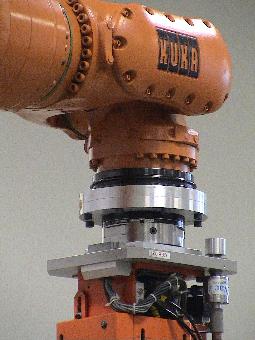| |
AMATEC Robotics GmbH(www.amatec.de)
Typically, robots move purely position-controlled on programmed trajectories without consideration of forces or torques that are acting on the tool or workpiece. In many cases, however, the adjustment or execution of exactly defined forces by the robot has a crucial influence on the quality and robustness of a robot application:

Tension-free positioning of parts e. g. insertion processes
-
Forces and torques can be adjusted independently from part position and tolerance e. g. for gluing and polishing
-
Complex force profiles can be applied onto workpieces during program execution e. g. robot-based drilling or roll-hamming
-
Compensation of part tolerances by programming an active compliance e. g. assembly tasks
-
Sensitive collision detection e. g. for handling functions
When used with an ATI six-axis force/torque sensor, the FTCtrl extends the traditional operation mode of KUKA robots with the possibility of programming nominal forces and torques instead of positions and trajectories. The overlay of position-controlled and force-controlled motions is also possible.
FTCtrl contains the following components:
-
KRL instruction set extension for the intuitive programming of force/torque-controlled robot applications
-
Configurable force/torque-controller embedded in the kernel of the robot controller.
-
Each of the six cartesian degrees of freedom can be alternatively controlled by a position control loop or a force/torque control loop
-
Drivers for ATI ISA-bus and DAQ sensor systems.
FTCtrl offers the following advantages:
-
Possibility of combination position and force-controlled programming in each movement instruction. The only condition: Each degree of freedom of the robot is subject either to the force/torque control or the position control.
-
Output of sensor-based error messages on the hand controller device of the robot control.
-
Simple adaptation of force/torque controller to the demands of the respective application (I.e. both the type of robot and also the mounted sensor as well as the dynamics of the process force profile (soft contact, hard contact) can be considered appropriately).
-
Numerical output of process forces and torques on the hand controller device of the robot control. Optionally also a graphical output can be integrated.
-
All force/torque controlled robot movements refer either to the current tool coordinate system (TCP) or robot-base coordinate system (Base) or trajectory-following coordinate system. Thus applications can be programmed fast and intuitively with respect to the best suited coordinate system.
Versatile security mechanism for protection of sensor and work piece:
-
Force/torque supervision: Adjustable threshold values release an error when exceeding.
-
Time control: process forces can be limited by programmable timers temporarily.
-
Trajectory supervision: The movements added by FTCTRL can be limited
(Johannes Stelter)
|
|
|
|